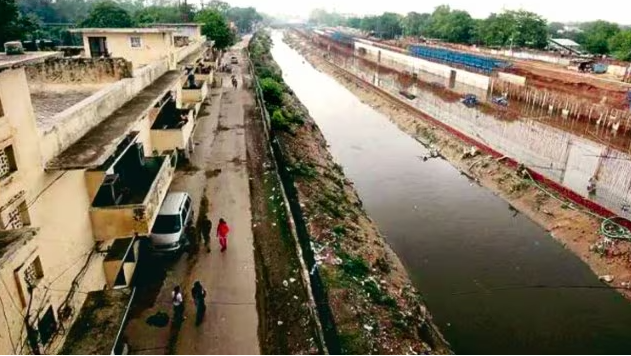DELHI: Once a rejuvenating tributary of the Yamuna River, the Barapullah drain has transformed into a symbol of monsoon chaos in Delhi. Originally a vital waterway refreshed by yearly rainfall, it now causes severe flooding, damaging homes and shops during even brief rain spells. The drain is heavily clogged with sewage and construction waste due to insufficient desilting and sewage treatment.
A Source of Monsoon Woes
The Barapullah drain, originally a Yamuna tributary, is now notorious for overflowing during monsoons, causing widespread damage. The lack of maintenance has turned it into a significant hazard for Delhi residents. Earlier, Delhi Mayor Shelly Oberoi pointed to the construction debris from the Regional Rapid Transit System (RRTS) as a major contributor to the blockage, exacerbating the flooding issues in Central and South Delhi.
The Route of Barapullah Drain
The Barapullah drain originates in Mehrauli and flows through several key areas, including Saket, Chirag Dilli, Savitri Nagar, and Defence Colony, before reaching Nizamuddin. It has multiple tributaries:
- One runs from RK Puram through Gautam Nagar, Seva Nagar, CGO Complex, and meets the main drain at Nizamuddin.
- Another stream carries water from Greater Kailash through LSR, Amar Colony, Central Market, Lajpat Nagar, Jangpura Extension, and Pant Nagar before joining the main drain at Nizamuddin.
The management of the drain is divided among various authorities: the PWD, the irrigation and flood control department, the NDMC, and the MCD.
Historical Significance
Historically, the Barapullah was an important tributary of the Yamuna River. Swapna Liddle, an author and historian, explains that the name “Barapullah” dates back to the era of Jahangir when a bridge with twelve pillars was built over the drain, giving it its name (“Barapullah” translates to “twelve pillars”).
Ongoing Battle for Cleanliness
The Nizamuddin Residents Welfare Association (RWA) has been fighting for 23 years to maintain the Barapullah drain, initially through the Supreme Court and now through the National Green Tribunal (NGT) for the past nine years. Despite numerous directives and the appointment of high-powered committees by the NGT, authorities like the state government, DJB, and DDA have repeatedly ignored court orders.
Efforts and Challenges
Efforts to dredge and desilt the Barapullah drain have faced significant obstacles, primarily due to the continuous dumping of debris and the lack of effective sewage treatment. Anil Goswami, Head of the Bhogal RWA, highlights the issue: “When the Commonwealth Games were scheduled for 2010, thousands of trucks of debris were dumped into the drain to create elevated ground for construction work. Over time, so much debris has accumulated that there is no space for the water to flow anymore… the agencies involved do not cooperate in cleaning the nullah.”
Conclusion
The Barapullah drain’s transformation from a Yamuna tributary to a monsoon bane is a stark reminder of the consequences of neglect and mismanagement. The ongoing legal battles and the community’s persistent efforts underscore the urgent need for coordinated action to restore this vital waterway to its former state.

